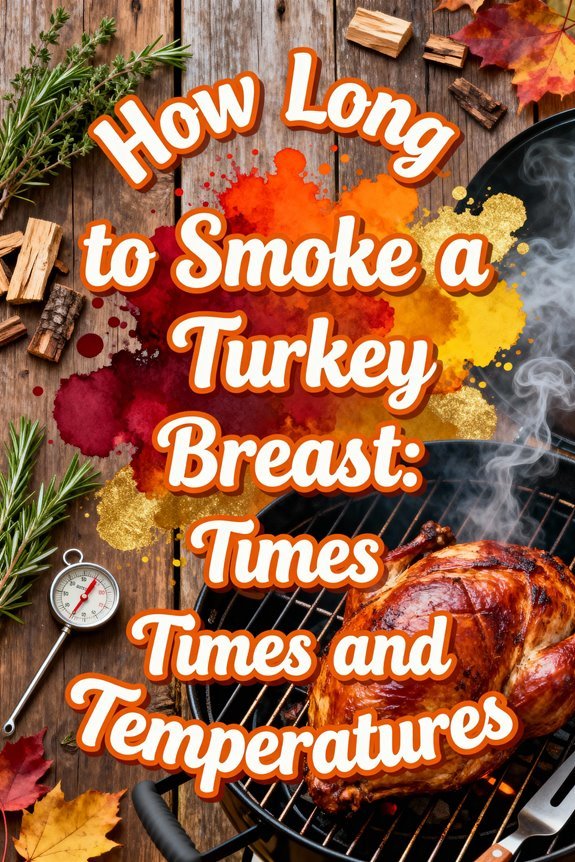You’ll want to smoke your turkey breast at 225°F to 250°F for approximately 30 to 40 minutes per pound until it reaches an internal temperature of 165°F at the thickest part. A typical 3-5 pound breast takes 1.5 to 2.5 hours, depending on whether it’s boneless or bone-in. Use a digital meat thermometer to monitor progress, and consider pulling it at 160°F to account for carryover cooking during the 15-20 minute rest. The guide below covers essential brining techniques, wood selection, and finishing methods for crispy skin.
Optimal Smoking Temperature Ranges for Turkey Breast
When smoking turkey breast, maintaining the right temperature range fundamentally determines your results—both in texture and flavor development. The low and slow method at 225°F to 250°F delivers ideal smoke absorption and moisture retention, requiring 30 to 40 minutes per pound. You’ll achieve tender, juicy meat with pronounced smoky flavor at this range. Stepping up to 275°F balances efficiency with quality, reducing cook time to approximately three hours for a 4-6 pound breast while producing crisped skin. Temperature control remains critical regardless of your chosen range—fluctuations extend cooking times and compromise tenderness. Higher temperatures above 300°F dramatically reduce smoking duration but risk drying the meat and diminishing smoke penetration. Consistent monitoring with wireless thermometers guarantees you maintain your target temperature throughout the cook. Apple wood pellets provide a subtle sweetness that perfectly complements turkey breast without overpowering its natural flavor. Beginners can successfully execute the smoking process by following straightforward steps: brining the turkey for 8-12 hours, patting it dry, applying your chosen rub, and smoking at your selected temperature. For optimal results, smoke the turkey breast side down to ensure the meat stays moist throughout the cooking process.
Internal Temperature Guidelines and Safety Standards
The single most critical factor determining your smoked turkey breast’s safety is achieving an internal temperature of 165°F (74°C) at the thickest portion of the meat. At this temperature, harmful bacteria like Salmonella and Campylobacter are instantly destroyed. Proper safety practices require using a digital meat thermometer inserted into the breast’s thermal center, avoiding bone contact for accurate readings. Effective temperature management means you can pull the turkey at 160–163°F, allowing carryover cooking to reach 165°F during a 30–45 minute rest period. While pasteurization occurs at lower temperatures with extended hold times, the 165°F standard remains your safest benchmark for home smoking. Many smokers achieve optimal results by maintaining a constant cooking temperature between 225°F and 275°F throughout the smoking process. For a perfectly cooked turkey breast, plan to smoke for approximately 25 minutes per pound until done. Always verify temperatures with a reliable meat thermometer rather than relying solely on built-in smoker gauges. After removing the turkey breast from the smoker, allow it to rest for 15-20 minutes to ensure proper juice redistribution throughout the meat.
Smoking Time Estimates by Weight and Temperature
Once you’ve mastered temperature safety standards, you’ll need accurate timing estimates to plan your smoke session effectively. At 225°F to 250°F, expect 30-40 minutes per pound for turkey breasts. A typical 3-5 pound piece requires 1.5 to 2 hours using standard smoking methods. Bone-in breasts may extend to 2.5 hours due to mass and heat penetration. You’ll achieve consistent results by maintaining stable smoker temperatures throughout the cook. Your seasonings choices won’t greatly affect timing, but thickness will—thicker cuts demand longer smoke sessions. Consider finishing at 275°F for the final 15-30 minutes to crisp skin. Always pull your breast at 160°F internal temperature, then rest 15-30 minutes. Using apple juice basting during cooking helps maintain moisture and adds subtle flavor. Carryover cooking completes pasteurization to 165°F while preserving moisture and preventing dryness. Utilizing bone-in cuts helps promote better heat distribution and moisture retention during the smoking process. Meat thermometer readings in the thickest part of the breast are essential for ensuring food safety and optimal doneness.
Brining and Pre-Smoking Preparation Techniques
Before you ignite your smoker, you’ll transform a standard turkey breast into moisture-rich perfection through proper brining. Dissolve 1 cup kosher salt in 1 gallon cold water, then enhance with brown sugar, garlic powder, and sage for balanced complexity. Submerge the breast completely for 8-12 hours refrigerated, ensuring uniform flavor penetration.
After brining, pat the surface bone-dry with paper towels—this critical step enables superior smoke absorption and bark formation. For optimal results, let the skin air dry overnight in the refrigerator to achieve maximum crispness. Apply turkey rubs post-drying; Cajun or sweet BBQ blends create an ideal crust when combined with light oil application. Position the breast bone-side down initially to retain juices, then flip halfway through smoking. Include brine ingredients like apple cider vinegar for tenderness, and select wood pellets matching your flavor profile. Consider creating a compound butter mixture with fresh herbs to rub under the skin for enhanced moisture and flavor.
Monitoring Temperature With Probes and Thermometers
With your brined and seasoned turkey breast ready for the smoker, accurate temperature monitoring becomes your primary safeguard against undercooked or dried-out meat. Insert your probe horizontally into the thickest part of the breast, positioning the tip 1/2 to 1 inch from the internal cavity. Proper probe placement guarantees you’re measuring the thermal center, not surface heat or bone-skewed readings.
Before smoking, verify probe calibration in ice water (32°F) or boiling water (212°F) for accuracy. Leave wired or wireless probes in place throughout smoking to avoid heat loss from opening the smoker. Set your high-temp alarm to 157–160°F; the breast will coast to the USDA-recommended 165°F during resting. Much like slow braising ribs at low temperatures, consistent temperature monitoring is crucial for tender, flavorful results. For added confidence, use both thermometer types together, with the leave-in probe tracking temperature continuously while an instant-read thermometer verifies final doneness. Smoking at lower temperatures around 250°F extends cooking time to about 50 minutes per pound but enhances flavor development. Cross-check with an instant-read thermometer before removing from heat.
Wood Selection and Basting During the Smoke
Your choice of smoking wood shapes the turkey breast’s final flavor profile as profoundly as your brine or rub selection. For beginners, apple, cherry, or alder deliver mild, forgiving smoke that won’t overpower delicate poultry. Pecan and maple add nutty sweetness, while hickory demands restraint—use sparingly to avoid bitterness. Effective wood pairing involves blending fruit woods like apple and cherry for complexity, while avoiding combinations of strong varieties that create harsh, acrid flavors. Just like a low and slow approach with brisket, patience is key for developing rich smoke flavor.
Monitor for thin, blue smoke; thick white smoke indicates incomplete combustion and ruins taste. Proper basting techniques involve applying broth, butter, or drippings every 30–60 minutes to maintain moisture without washing off your rub. Spritzing with apple cider adds subtle sweetness. Collect pan drippings for gravy, maximizing flavor from every element of the smoke. For optimal fuel, use all-natural charcoal without fillers or chemicals to ensure clean-burning heat that won’t introduce unwanted flavors to your turkey breast. Adding a water pan helps maintain consistent humidity levels and prevents the meat from drying out during long smoking sessions.
Resting, Carving, and Serving Your Smoked Turkey Breast
After you’ve pulled your turkey breast from the smoker, the work isn’t finished—proper resting determines whether those hours of careful temperature management pay off or result in dry, unevenly cooked meat. Allow 15-30 minutes for juices to redistribute, wrapping loosely in foil to retain heat without trapping steam. Carryover cooking will add 5-10°F, so pull your breast at 157°F to reach the FDA-recommended 165°F safely. Maintaining steady smoker temperatures between 220-250°F during cooking ensures optimal smoke flavor development.
For carving methods, use a sharp knife and slice against the grain immediately after resting. Cut only what you’ll serve to preserve moisture. If you brined your turkey breast, you’ll notice more flavorful meat with improved moisture retention throughout the slicing process. Like smoking chicken, dry rub seasoning helps create a flavorful exterior crust while preserving interior moisture. Serve warm, not piping hot, for ideal flavor and texture.
These resting techniques separate good barbecue from great barbecue—they’re non-negotiable if you want tender, juicy results.







